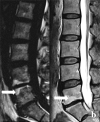Myofascial and discogenic origins of lumbar pain: A critical review
- PMID: 37503571
- PMCID: PMC10642329
- DOI: 10.1080/10669817.2023.2237739
Myofascial and discogenic origins of lumbar pain: A critical review
Abstract
The purpose of this three-part narrative review is to examine the anatomy of, and the research which supports, either the lumbar myofascia or intervertebral disc (IVD) as principal sources of our patient's low back pain. A comprehensive understanding of anatomical lumbar pain generators in combination with the current treatment-based classification system will further improve and enhance clinical decision-making skills. Section I reviews the anatomy of the spinal myofascia, myofascial sources of lumbar pain, and imaging of myofascial tissues. Part II reviews the anatomy of the IVD, examines the IVD as a potential lumbar pain generator, and includes detailed discussion on Nerve Growth Factor, Inflammatory Cytokines, Vertebral End Plates and Modic change, Annular tears, and Discogenic instability. Part III looks at the history of myofascial pain, lab-based research and myofascial pain, and various levels of discogenic pain provocation research including animal, laboratory and human subjects. Our review concludes with author recommendations on developing a comprehensive understanding of altered stress concentrations affecting the posterior annulus fibrosis, neo-innervation of the IVD, inflammatory cytokines, discogenic instability, and how this knowledge can complement use of the Treatment-Based Classification System.
Keywords: Myofascial back pain; discogenic lumbar pain; low back pain; lumbar disc degeneration; manual therapy.
Conflict of interest statement
No potential conflict of interest was reported by the author(s).
Figures





References
-
- Lieber RL. Skeletal muscle structure, function, and plasticity: the physiological basis of rehabilitation. 3rd ed ed. Baltimore, MD: Lippincott Williams & Wilkins; 2010.
-
- Bogduk N, Twomey LT. Clinical anatomy of the lumbar spine. 2nd ed ed. Melbourne: Churchill Livingstone; 1991.
Publication types
MeSH terms
Substances
LinkOut - more resources
Full Text Sources
Miscellaneous
